BY MARY ANN O’DELL, MS, RDN
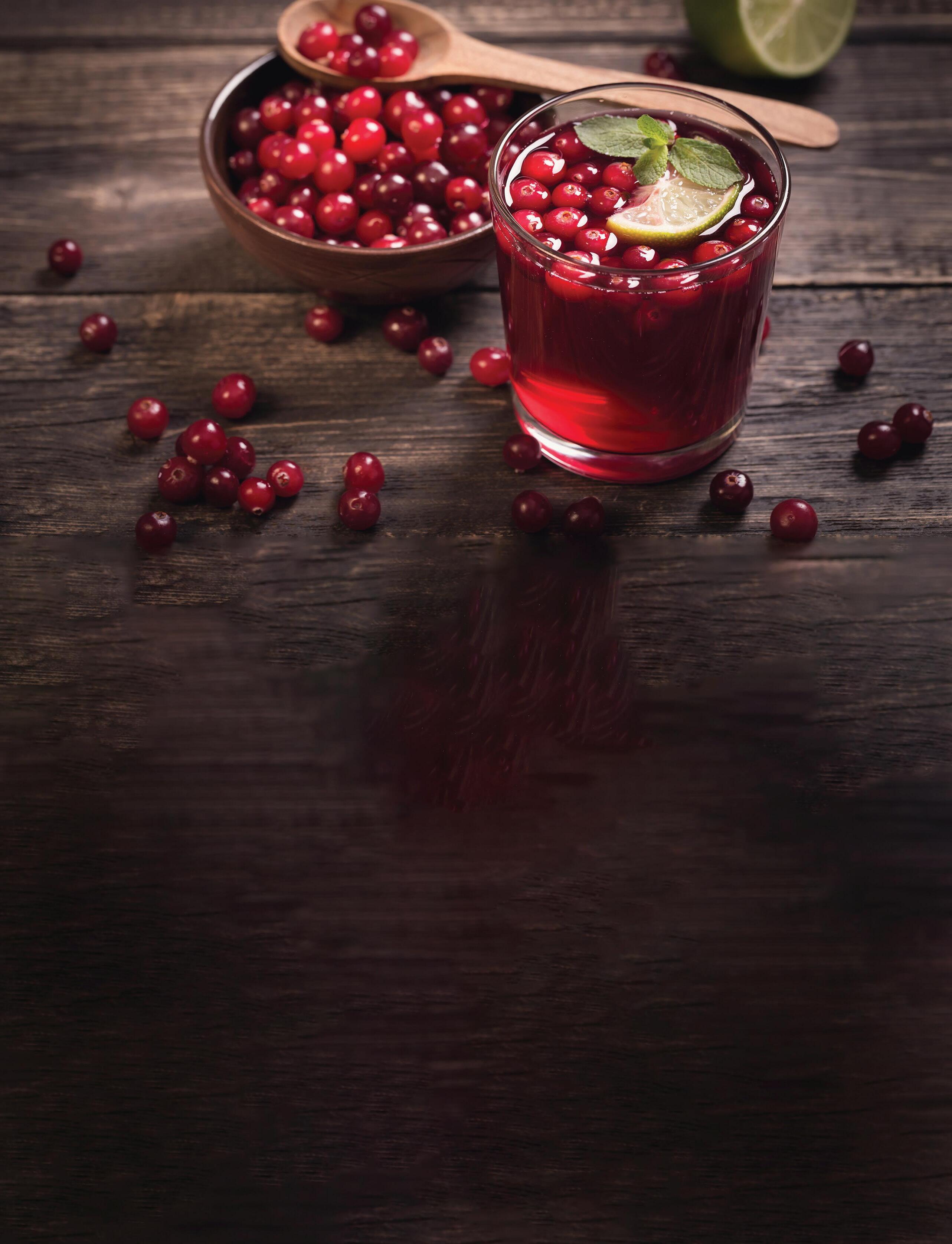

BY MARY ANN O’DELL, MS, RDN

The festive holiday season is the time for that little red berry, the tart cranberry, to really shine! It can be seen on trees, in beverages, and as part of the holiday feast, but cranberry is much more than a condiment or decoration. Rich in vitamin C and other antioxidants that may help protect against infections and heart disease, the cranberry has become a popular herbal remedy year ’round.
Medicinal Uses of Cranberries:
Gut Health. Research has found that cranberries can support the beneficial bacteria in the gut that are tied to immunity, mood, and digestive health. It is thought that antioxidants and other compounds can protect gut microflora, which in turn can result in antioxidant and anti-inflammatory protection in other systems of the body. And since cranberries are a good source of fiber, they can help reduce constipation and support overall digestive health.
Heart Health. Compounds in cranberries help improve the flexibility and health of arteries, resulting in better circulation and blood flow. One study found that participants who consumed strong cranberry juice had a significant reduction in arterial stiffness, an indicator of heart disease. Another study found that daily consumption of cranberry for a month raised HDL “good” cholesterol by 10 percent, reducing the risk for heart disease.
Urinary Tract Health. Most people know cranberry for this use. Studies have demonstrated that cranberry
juice and cranberry supplements can help reduce the risk and recurrence of urinary tract infections (UTIs). One study showed that cranberry capsules lowered the risk of UTI by 50 percent—even more than cranberry juice. It is known that the PAC flavonoids in cranberries interfere with the ability of pathogenic bacteria to cause infections in the urinary tract.
Cranberry is available fresh, dried, or in juice form. It is important to note that cranberries are naturally sour, so most cranberry juice cocktails contain added sugar. When drinking cranberry juice, look for 100 percent cranberry juice or 100 percent pure cranberry juice blends to avoid the excess sugar. In addition, cranberry concentrates are available in supplement form, which offer the benefits of cranberries without the extra calories. ●
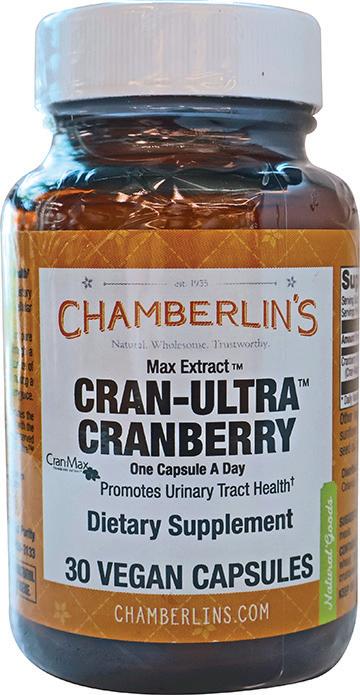
Chamberlin’s
Max Extract™
Cran-Ultra™ Cranberry
Promotes urinary tract health.*
Provides antioxidant support.*
Produced from pure cranberry fiber infused with cranberry extract for a concentrated formula.

Spices take center stage in cuisines from around the world. They can transform even the simplest ingredients into unforgettable meals. Crafting your own spice blends at home is economical and fun. Here are some classic blends that take home cooking to the next level.
A zesty, aromatic blend perfect for seasoning meat, beans, vegetables, and Mexican-inspired dishes.
1 Tbsp chili powder
1 tsp ground cumin
½ tsp garlic powder
½ tsp smoked paprika
½ tsp oregano
½ tsp sea salt
Pinch black pepper
Pinch ground cayenne pepper or red pepper flakes
1 Tbsp corn starch
A fragrant French blend perfect for chicken, fish, vegetables, and marinades.
2 Tbsp dried thyme
2 Tbsp dried savory (or marjoram)
2 Tbsp dried rosemary
2 Tbsp dried oregano
1 Tbsp dried basil
1 Tbsp dried tarragon
1 Tbsp dried lavender buds (optional but traditional)
A rich blend from India that is best added near the end of cooking time.
1 Tbsp ground cumin
1 Tbsp ground coriander
1½ tsp ground cardamom
1½ tsp ground black pepper
1 tsp ground cinnamon
½ tsp ground cloves
½ tsp ground nutmeg
With deep roots in Eastern Europe, this spice blend can be used for brines, corned beef, and preserving vegetables.
1 Tbsp mustard seeds
1 Tbsp coriander seeds
1 Tbsp dill seeds
1 Tbsp allspice berries
1 tsp black peppercorns
4 bay leaves, crumbled
2–3 whole cloves
1 small cinnamon stick, broken into small pieces
• Whisk and stir all spices together in a small bowl until well mixed.
• Be sure to read recipes carefully. Some spice blends feature whole spices, while others work best with ground spices.
• Store your spice blends in airtight jars, away from heat and light, to preserve flavor.
• Label and date your spice blends to make sure you are enjoying them at peak freshness. Most blends stay potent for 3–6 months.
SELECTED SOURCES “Get to know your spice rack,” Academy of Nutrition and Dietetics, www.EatRight.org, 12/11/23 • “Our guide to storing and organizing spices” by C. Grillo, America’s Test Kitchen, 11/13/20
An aromatic blend that balances sweet, sour, bitter, salty, and umami.
1 Tbsp ground cinnamon
1 Tbsp ground star anise
1 Tbsp ground fennel seed
1 Tbsp ground black peppercorns
1 Tbsp ground cloves
A sweet American classic perfect for adding to baked goods or blending into lattes or oatmeal.
3 Tbsp ground cinnamon
2 tsp ground ginger
2 tsp ground nutmeg
1½ tsp ground allspice
1½ tsp ground cloves
A Middle Eastern favorite for breads, dips, and roasted vegetables.
2 Tbsp dried thyme
2 Tbsp ground sumac
2 Tbsp sesame seeds, lightly toasted
1 Tbsp dried oregano
1 Tbsp dried marjoram

½ tsp salt (optional)

For thousands of years, people have turned to tea for its ability to calm and heal, and tea is particularly suited to the colder months. Here is a selection of herbal teas to warm you up, support your digestion, and help to ward off cold, flu, and other respiratory infections.
Chamomile tea is used to promote relaxation and ease the transition to sleep. Some research suggests that chamomile may help lower heart disease risk, support a healthy immune response, and slow agerelated bone loss. It may also help ease a host of digestive issues, including diarrhea, constipation, acid reflux, and nausea.
Cinnamon bark tea offers a sugar-free way to satisfy your sweet tooth. It also has anti-inflammatory and antimicrobial activity, and it shows promise in helping to slightly reduce post-meal blood glucose levels in adults without diabetes.
Elderberry tea has compounds that may help to block cold and flu viruses from entering cells and reduce their ability to spread. It’s best to take elderberry as soon as you start to feel sick. You can also take it regularly to keep viruses at bay.

Ginger tea has a spicy, warming effect and also works to beat back viruses. Ginger is great for reducing inflammation and pain, and may help to settle an upset stomach.
Hibiscus tea is red and fruity, and tastes similar to tart cranberry juice. It contains anthocyanin and bioflavonoid compounds similar to those found in superfood berries.
Peppermint tea is a natural decongestant that can slow the production of histamines and the symptoms that go with them. It also helps heal the entire digestive system, offering relief from diarrhea, bloating, gas, indigestion, and nausea. ●
SELECTED SOURCES “Cinnamon,” National Center for Complementary and Integrative Health, https://www.nccih.nih.gov, 11/24 • “The health benefits of 3 herbals teas,” Harvard Health Publishing, https://health.Harvard.edu • “The best teas to drink for your health,” 8/13/21; “What elderberries can (and can’t) do for your health,” 6/13/25, Cleveland Clinic Health Essentials, https://health.ClevelandClinic.org
Green tea, brewed from the unfermented dried leaves and buds of the Camellia sinensis plant, is packed with powerful healing nutrients and antioxidants that can potentially help ward off cancer, heart disease, and Type 2 diabetes. Some studies have indicated that green tea can also help improve brain function and aid in fat loss.
The secret is in the leaves, which contain a powerful antioxidant compound called epigallocatechin gallate. EGCG minimizes free radicals, fights inflammation, lowers LDL cholesterol, and reduces your risk of a number of life-threatening diseases.
Green tea has been shown to reduce blood sugar levels and lower the risk of developing Type 2 diabetes and cardiovascular disease.
Green tea may also help when it comes to preventing

cancer. Research has found that women who regularly drank more than three cups of green tea a day had a lower risk of both developing breast cancer and experiencing a recurrence of breast cancer. And 29 different studies found that green tea drinkers were less likely to develop colorectal cancer.
SELECTED SOURCES “Effect of green tea on glucose control and insulin sensitivity: A meta-analysis of 17 randomized controlled trials” by K. Liu et al., American Journal of Clinical Nutrition • “Effects of green tea and its epigallocatechin (EGCG) content on body weight and fat mass in humans: A systematic review” by L. Vázquez Cisneros et al., Nutricion Hospitalaria, 6/5/17 • “An inverse association between tea consumption and colorectal cancer risk” by Y. Chen et al., Oncotarget, 6/6/17 • “Green tea and its relation to human gut microbiome” by S. Pérez-Burillo et al., 6/26/21; “A review on the weight-loss effects of oxidized tea polyphenols” by D. O’Neill Rothenberg et al., 5/14/18, Molecules • “Green tea promotes weight loss in women with polycystic ovary syndrome: Systematic review and meta-analysis” by L. Colonetti, Nutrition Research, 8/22 • “The relation between green tea consumption and cardiovascular disease . . .” by S. Kuriyama, Journal of Nutrition
It’s that time of year when the sniffles sneak in. Alongside a healthy diet, exercise, and supplements, yoga may provide the extra boost needed to feel better through the year’s final stretch.

Modern research affirms ancient wisdom: yoga supports immune health. Through breathwork, movement, and meditation, yoga regulates stress, reduces inflammation, and promotes lymphatic circulation—strengthening the body’s defenses. Studies increasingly link its calming effects to improvements in immune function.
If beginning a practice at your local yoga studio sounds daunting, begin slowly at home. If it seems challenging to start a consistent routine, know you are not alone. Here are some tips to begin.
Be realistic about what time you have available to commit to a yoga practice. If you start with five minutes, that’s fine. You can always increase your time later.
Try this before beginning your day.
1. Find a quiet space in your home to roll out a yoga mat and keep it there.
2. Each morning sit or stand on your mat.
3. Notice the quality of your breath. Is it smooth, shallow, or deep? Allow it to be what it is.
4. Scan your body. Begin at the top of your head and
move through each body part as you work your way down to each toe. Without judgment, notice sensations such as where your body aches or feels tight, and notice what feels open and free.
5. Bring your awareness back to your breath. Without force, regulate your breath by drawing air in through your nose for a count of four and releasing the breath through your nose for a count of four.
6. As you settle into your breathing rhythm, allow your mind to observe any thoughts that arise, letting them drift away like leaves falling from a tree.
This gentle presence prepares your body and mind for the day ahead. Even just a few minutes spent in this state of awareness can foster clarity and resilience, reinforcing your body’s natural defenses.
When ready, add simple stretches that feel nourishing. Consistency matters more than intensity. Over time, this practice can become a cherished ritual for well-being. ●

Jones holds a Master of Science in Yoga Therapy from the Maryland University of Integrative Health. She has provided yoga therapy services in collaboration with clients in Alabama, North Carolina, Maryland, and New Hampshire.
SELECTED SOURCES “The effect on the immune system in the human body due to COVID-19: An insight on traditional to modern approach as a preventive measure.” by J. Sutradhar and B.R. Sarkar, Journal of Pharmacopuncture, 12/31/21 • “The role of yoga in inflammatory markers” by C. Estevao, Brain, Behavior & Immunity Health, 2/1/22 • “Yoga and immune system functioning: A systematic review of randomized controlled trials” by R.I. Falkenberg et al., Journal of Behavioral Medicine, 8/18
Looking for more ways to build up your defenses during cold and flu season? Here are some superstar nutrients to consider adding to your daily regimen.
✔ Elderberry is an antioxidant, antiinflammatory, and antiviral powerhouse that may help reduce the length and severity of a cold or flu. Supplements are available in syrup, gummy, and capsule forms. Elderberry may affect blood sugar levels, so people with diabetes should check with their healthcare practitioner before taking it.
✔ Vitamin A helps to prevent infections by maintaining the body’s physical barriers. Vitamin A is present in many foods, including leafy green vegetables (broccoli, kale, spinach), orange and yellow vegetables (carrots, pumpkin, sweet potatoes, summer squash), beef liver, cantaloupe, eggs, fish oil, mango, milk, tomatoes, and some fortified foods.
✔ Vitamin C plays a role in the body’s immune system by jump-starting white blood cell activity. It can be found in many fruits and vegetables, including bell peppers, citrus (grapefruit, lemons, oranges), cruciferous vegetables (broccoli, Brussels sprouts, cabbage, cauliflower), strawberries, tomatoes, and white potatoes.
✔ Zinc has the potential to enhance immunity, but getting an early start with this cold-busting nutrient is the key to success. The best food sources of zinc include fish, meat, seafood, eggs, and dairy. Fortified breakfast cereals, beans, nuts, and pumpkin seeds are good plantbased sources of zinc.
SELECTED SOURCES “Vitamin A”; “Vitamin C,” Nutrition Source, Harvard T.H. Chan School of Public Health, www.hsph.harvard.edu, 2023 • “Zinc,” Office of Dietary Supplements, National Institutes of Health, http://ods.od.nih.gov • “Elderberry for prevention and treatment of viral respiratory illnesses: A systematic review” by L.S. Wieland et al., BMC Complementary Medicine and Therapies, 4/7/21

BY MARY ANN O’DELL, MS, RDN

’Tis the season for . . . the blues? It’s something everyone deals with at some point, and many people experience mild depression, or “the blues,” around the holidays. If you know someone is feeling blue, check in on them to help them stay connected. Depression and stress can increase digestive troubles, sleeping issues, and other health issues. For many, some of the factors that contribute to mild depression can be controlled and changed to help reduce the chance of experiencing depression. Here are 4 tips to help fight the blues.
✽ Movement helps mood. Exercise raises levels of endorphins, those feel-good hormones which are commonly found to be low in depression. Exercise is

Paragon Plus™
Chewable
L-Theanine 200 mg Supports healthy relaxation without drowsiness.*
Supports healthy mental clarity and focus.*
200mg AlphaWave brand L-Theanine in a natural lemonade flavor chewable tablet.
associated with decreased anxiety and depression and increased self-esteem and happiness. Find something you enjoy, be it yoga, walking, weight training, or dancing. Just find a way to consistently add movement to your day. Something as simple as even a short, brisk walk can help lift your mood.
✽ Rest enhances rejuvenation. Lack of sleep means less time for your body to recuperate from the previous day’s activities. The result can be irritability, moodiness, and even adrenal exhaustion. Be sure to cut back on caffeine, especially later in the day, to avoid sleep problems associated with overstimulation. Try doing deep breathing exercises in the evening to calm body and mind. Sip on chamomile tea, or take an
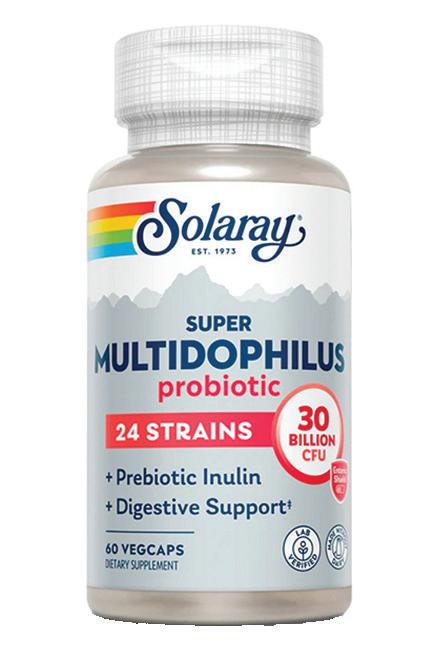
Solaray Super Multidophilus
Probiotic 24
24 strain probiotic with prebiotic inulin. Formulated to help support normal absorption of nutrients in the digestive tract.* May help boost overall wellness.*

herbal sleep formula to enhance nighttime rest.
✽ Controlling stress calms nerves. Adaptogens, such as rhodiola and ashwagandha, can help by balancing the body’s response to physical and emotional stress, promoting an increase in physical and emotional endurance. Research also suggests that deficiencies of vitamin B12 and folic acid may be related to the development of depression, and since the B vitamins are used up faster during stressful situations, they should be replenished on a daily basis.
The amino acid L-Theanine supports relaxation without sacrificing alertness, making it a great support solution for day or night.
✽ Happiness takes guts. It is now understood


that the gut plays a major role in neurologic health. Scientists have discovered the second brain—neurons in the intestinal tract that communicate like neurons in the brain. The discovery that mood-supporting chemicals like serotonin are produced by the gut has shifted research to focus on the gut-brain connection. Inflammation in the gastrointestinal (GI) tract can play a role in developing depression and “brain fog.” On the other hand, controlling inflammation, improving gut lining health, and supplementing with probiotics may result in more GI balance, improvement in brain function and even a reduction in symptoms of mild depression. ●
Paragon Plus™
Rhodiola
Pure™ 500 mg
Adaptogenic herb.*
Helps the body adapt to stress of daily life.*
Supplies 500mg of standardized Rhodiola extract.
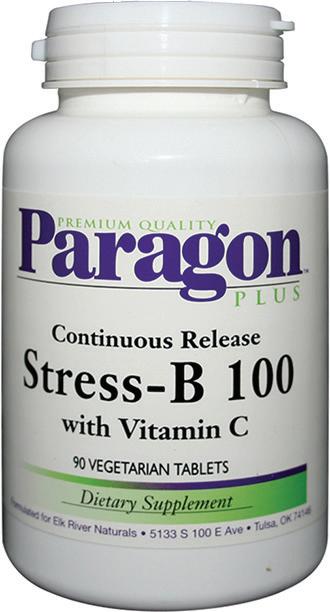
Plus™
Stress-B 100
High potency B complex with vitamin C.
May provide support during times of stress.*
Continuous release formula for maximum absorption.
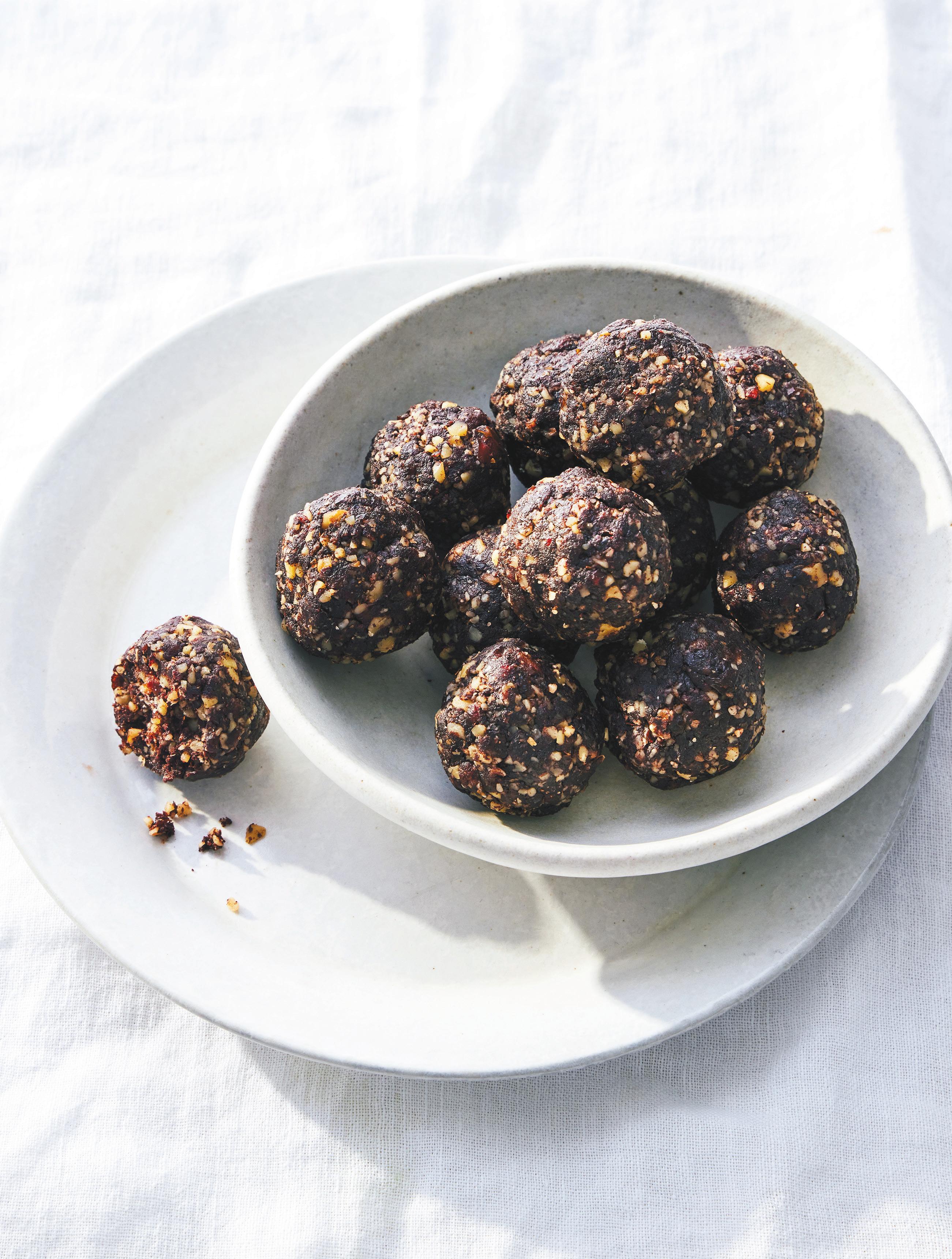
From In Good Health by Rachel Riggs ($34.95, Figure 1 Publishing, 2025)
1½ c toasted walnuts
10 plump Medjool dates, pitted
¼ c cocoa powder
2 Tbsp pure maple syrup
1 Tbsp coconut flour (use a knife to level) Scant 1 tsp salt
1 tsp vanilla extract
1. Combine all ingredients in a food processor and pulse until combined with visible walnut
Are you craving a bite that’s sweet? Or maybe savory’s more your style? When it comes to a midafternoon nosh, these two easy-to-make recipes satisfy just about anyone’s snack preference.
bits. Be careful not to over process mixture, or oils will separate and make balls greasy.
2. Using a medium-size cookie scoop, scoop dough and roll into balls. Place them on a small baking sheet lined with parchment paper, keep uncovered, and freeze them for 1 hour to hold their shape. Transfer to a glass jar and store in fridge for up to 2 weeks or in the freezer for up to a month. (They hold up best when frozen.)
20 min prep time + 1 hr freeze time makes about 13 balls
Kitchen Note: Reach for one of these rich, chocolatey walnut bites when less-thanhealthy treats are beckoning. These energypacked snacks last for a couple of weeks when refrigerated and even longer when frozen.
Per serving (1 ball): 157 Calories, 3 g Protein, 0 mg Cholesterol, 19 g Carbohydrates, 15 g Total sugars (2 g Added sugars), 3 g Fiber, 9 g Total fat (1 g sat), 88 mg Sodium, ★ Magnesium, Phosphorus
1 tsp cumin seeds
2 (14 oz) cans cannellini beans, drained
2 garlic cloves, crushed
Finely grated zest of 1 small unwaxed orange and juice of ½ of the orange
3½ oz feta cheese, finely crumbled
Olive oil, plus extra for serving
Sea salt flakes and freshly ground black pepper
10 mint leaves (about), rolled up tightly and thinly sliced into ribbons, some reserved for garnish
¼ oz dill, finely chopped, some reserved for garnish
1 tsp chili flakes, plus extra to serve
Toasted bread and/or crudités to serve

1. Heat a small, dry frying pan over mediumhigh heat. Add cumin seeds and toast for a couple of minutes until they release their aroma, shaking pan occasionally to prevent them from burning. Tip onto a plate and leave to cool, and then roughly crush using a pestle and mortar.
2. Put beans, garlic, orange zest and juice, feta, crushed cumin seeds, and a drizzle of olive oil into a food processor along with a good amount of salt and pepper. Blitz, gradually adding a little warm water or more olive oil to achieve a smooth consistency (don’t add too much to make it watery or runny).
20 min prep time
serves 4
3. Decant mixture into a mixing bowl, stir in herbs and chili flakes. Check and adjust seasoning, if desired. Serve garnished with reserved herbs, chili flakes, and a little drizzle of olive oil, with some toasted bread on the side and/or crudités for dipping.
Kitchen Note: While hummus is fantastic, sometimes you want to serve something a little different. This is just the recipe for you. Great with crudités or crisps, as well as toasted bread for dipping.
Per serving (made with 2 tablespoons olive oil and served with 2 slices of baguette per serving): 469 Calories, 25 g Protein, 22 mg Cholesterol, 64 g Carbohydrates, 3 g Total sugars (0 g Added sugars), 14 g Fiber, 13 g Total fat (5 g sat), 630 mg Sodium, ★★★★★Folate,★★★★Iron,Phosphorus,★★★VitaminB1(thiamine),B2 (riboflavin), Calcium, Magnesium, Zinc, ★★ Vitamin B6, E, Potassium, ★ Vitamin B3 (niacin), B12, C, K
LISA FABIAN
Maybe you have been there: You stick to a diet, lose weight, abandon the diet, and then put the pounds back on.
This yo-yo cycle is not necessarily your fault. Research indicates that it happens to most people who are trying to lose weight.
Long-term dieting can destroy your relationship with food, and it can end up hurting you more than helping you when it comes to your weight-loss goals.
What can you do when faced with such a vicious cycle? Consider approaching food more thoughtfully, that is . . . eating intuitively.
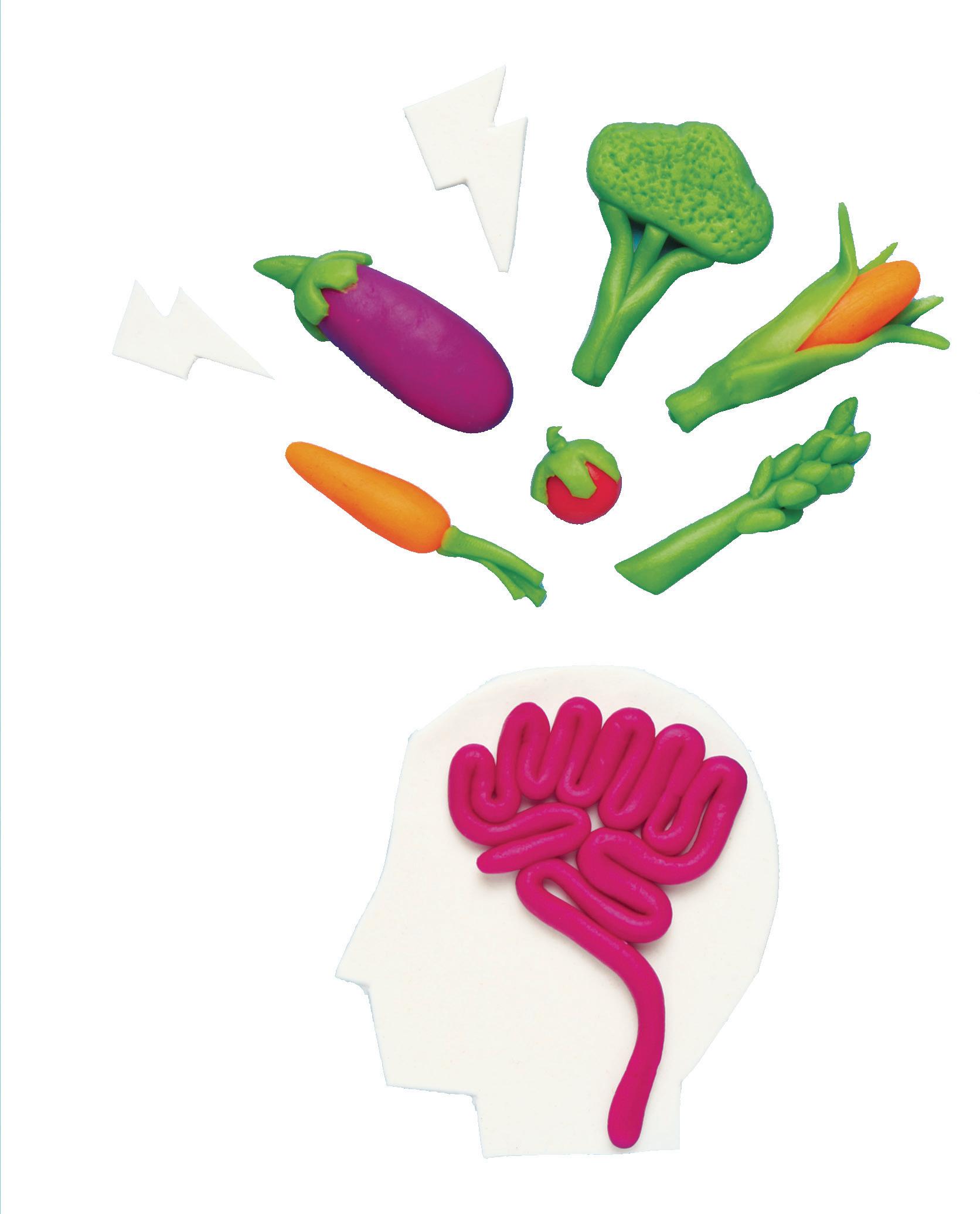
Created by registered dietitian Evelyn Tribole and nutrition therapist Elyse Resch, intuitive eating is about tuning in to your body’s hunger signals and choosing a wide variety of foods that satisfy.
Intuitive eating is not a diet or weight-loss plan. There’s no calorie, fat, or carb counting. Its premise is simple: Eat when you’re hungry; stop when you’re full.
When you give yourself leeway to eat the foods you desire, cravings most likely will diminish. And if you consume what your body truly desires, you’re less likely to overeat and will be able to better recognize feelings of fullness.
To start eating intuitively, listen to your body’s signals to see if you’re physically hungry. Many people may be
used to consuming food whenever they see something tasty or eating at certain set times—whether they’re hungry or not.
The signs of hunger can include a gnawing or empty feeling in the stomach, a headache, feeling irritable, or getting tired.
Consider what you want to eat. Ask yourself: Will this satisfy me? Do I really want this? Is there something else that may be more satiating?
Take time to taste and savor your food. Pause midmeal to assess fullness levels. When you feel satisfied, stop. Be gentle with yourself if you slip up and eat more than intended. ●
SELECTED SOURCES Intuitive Eating by Evelyn Tribole and Elyse Resch ($19, St. Martin’s Essentials, 2020) • “Mindful eating, intuitive eating, and the loss of control over eating” by B.L. Bennett and J.D. Latner, Eating Behaviors, 12/22 • “Trust your gut: A beginner’s guide to intuitive eating” by M. Godoy, www.NPR.org, 11/5/19 • “What is intuitive eating?” by E. Tribole www.IntuitiveEating.org • “What is intuitive eating? 10 principles to follow,” https://health.ClevelandClinic.org 6/8/22
To remove obstacles to body awareness, here are some principles from Evelyn Tribole and Elyse Resch.
• Give yourself unconditional permission to eat. Don’t tell yourself that you can’t or shouldn’t have certain foods. This leads to feelings of deprivation and can lead to uncontrollable cravings and binges.
• Get rid of the articles and diet books that promise false hope of dropping weight instantly and permanently. Clinging to even one small promise that this will be the time it works will prevent the success of eating intuitively.
• Eat in an inviting and calming environment to bring pleasure to the meal and help you feel more satisfied with the food.
• Resist the temptation to eat out of sadness, boredom, loneliness, or anxiety. In the short term, emotional eating provides distraction from pain. But in the long term, you’ll feel worse and will still have to deal with the emotions. Food doesn’t fix feelings.
• Honor the body you were born with. It’s unrealistic to disregard your genetic blueprint. Respect and honor your shape, so you can feel better about yourself.
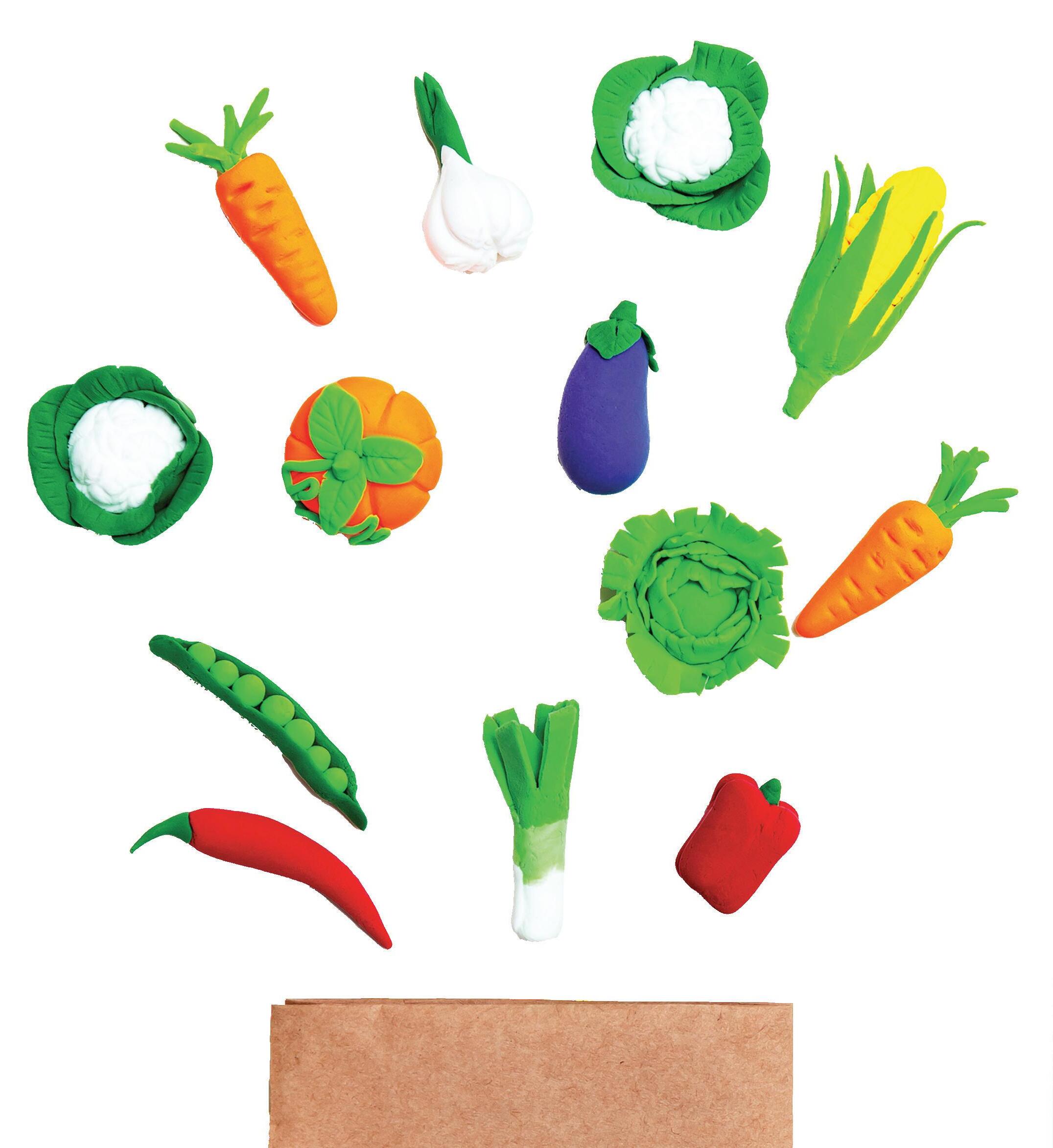


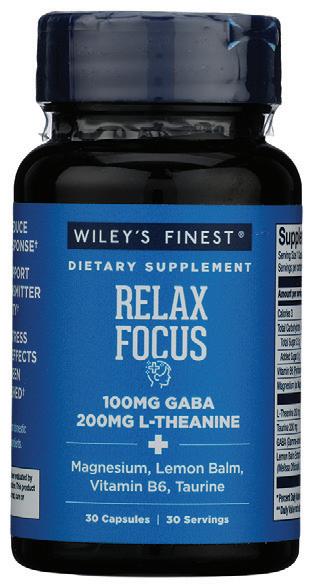
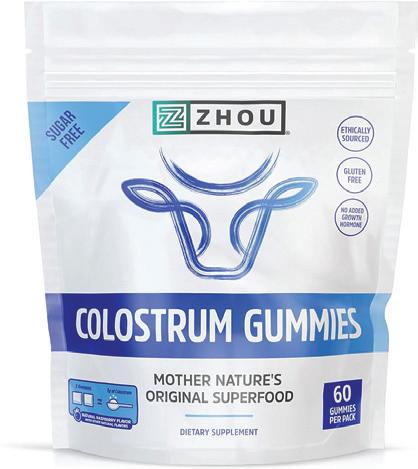
Shikai
Borage Therapy
Dry Skin Lotion
The dry skin solution. Contains critical Omega-6 GLA to soothe dry skin. Keeps skin healthy and supple long after the lotion is applied.

Hyland’s Kids
All-in-One Cough Syrup
Natural cough syrup + immune support with no artificial colors or flavors.
Daytime Formula eases mucus, cough and throat irritation.* Nighttime Formula promotes sleep and eases cough.*
Wiley’s Finest Relax Focus
Helps reduce stress response.*
Helps support neurotransmitter activity.*
With 100 mg GABA plus L-theanine, magnesium and lemon balm.

Jonzac Rehydrate Hydrating Serum
Formulated with Jonzac hypermineralized thermal spring water and hyaluronic acid.
Fills the skin with water to hydrate and soothe. 24-hour natural hydration. Vegan friendly.
Zhou Nutrition Colostrum Gummies
Mother Nature’s original superfood.*
Clinically studied ingredient for whole body benefits.*
Two sugar free gummies = 1 g colostrum. Gluten free.
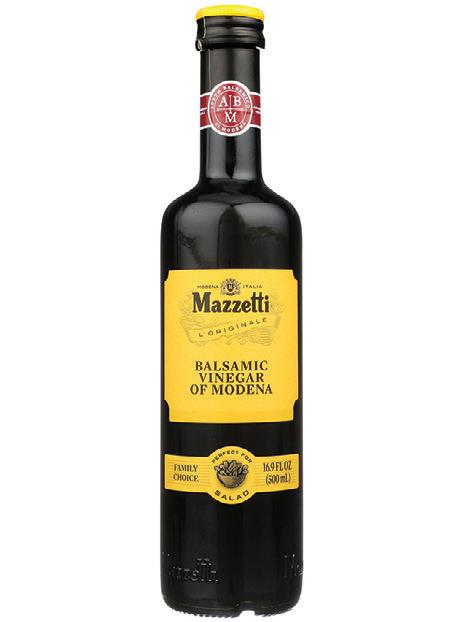
Mazzetti
Balsamic Vinegar of Modena
The perfect pantry staple. Light and tangy.
Great for dressings, marinades, bread dip, or for lifting the flavor of a sauce or soup.
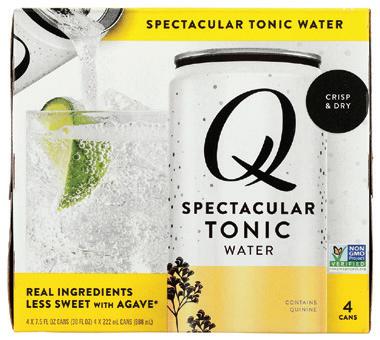
Q Tonic Premium Tonic Water
Crisp and dry.
Infused with real quinine, organic agave and optimal carbonation.
For a bold, classic taste without a sugar bomb.

Honey Gardens
Elderberry & Honey Immune Drink
Get nourishment from every sip.
A delicious blend of black elderberry juice and organic honey.
Includes tart cherry juice and organic apple cider vinegar for additional benefits.

3005 W Lake Mary Blvd 407-936-9470
1086 Montgomery Rd 407-774-8866 Lakewood
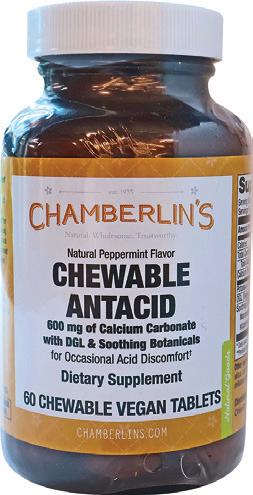
6574 University Pkwy Sarasota , FL 941-210-3524
For occasional acid discomfort.*
Plus DGL and soothing botanicals to support the gastrointestinal tract lining.*
Natural peppermint flavor.